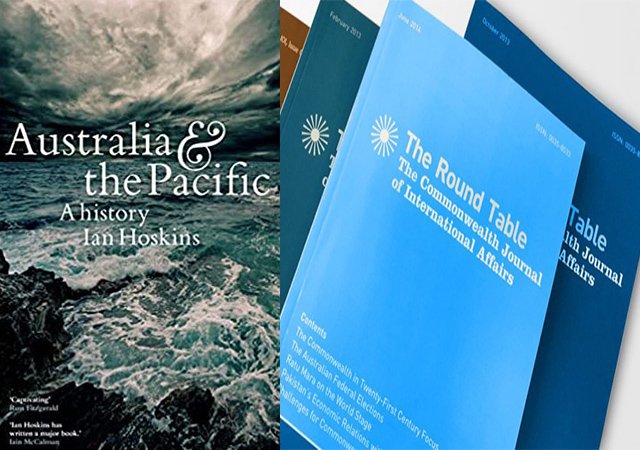
[This is an excerpt from an article in The Round Table: The Commonwealth Journal of International Affairs.]
This book makes one appreciate the importance of the oceanic dimension in Australia’s history. Given the Pacific orientation, the focus is on eastern Australia. One reads with interest that before 1817 the authority of the governor of New South Wales extended east, including not just Norfolk Island and New Zealand, but going as far as Tahiti. It was not inevitable that ‘Australia’ (meaning the Commonwealth of Australia) would emerge as the Australian continent plus Tasmania. For a period in the 1890s New Zealand was a possible federation partner. There have been various developments over time concerning Australia’s links with the Pacific islands (especially in relation to what is now Papua New Guinea), but political incorporation as an option has never proceeded very far.
In the book there are 20 substantive chapters, starting off with pre-history and natural history, and the long history of the first peoples, and concluding with the issue of climate change. The order is roughly chronological with the chapters focusing on broad topics, covering early exploration in the Pacific region and Australia, the establishment of New South Wales as a Pacific colony, various links between Australia and the Pacific islands (such as missionary activity and the role of indentured labour from Melanesia (‘blackbirding’)), the development of the White Australia Policy, and the experience of the two world wars in the Pacific context.
Opinion – China ups the ante: the new Chinese security agreement with Solomon Islands
Solomon Islands’ security pact with China sends shockwaves across Pacific
Book Review – Tides that bind: Australia in the Pacific
There are seven chapters for the post-1945 period. Chapter 13 (entitled ‘Governing Papua and New Guinea’) covers immediate post-war issues rather than focusing solely on Papua and New Guinea. Chapter 14 (‘Learning from the Pacific’) discusses the ways in which Australians have studied the Pacific, including through anthropology and art history (Bernard Smith, European Vision and the South Pacific (1957) being particularly notable). In chapter 15 there is an interesting discussion of the views of conservative academic and poet James McAuley on Australia’s cultural crisis, focusing on McAuley’s negative assessment of modernity but also giving attention to the way in which the Western encounter with the Pacific had exacerbated this crisis. The chapter title (‘Post-war Australia meets the Cold War Pacific’) does not do justice to the content of the chapter. While it is highly appropriate to have a whole chapter on climate change (chapter 20), given the existential threat posed to the island countries (and their dissatisfaction with Australian policy on this matter), chapter 19 on the Pacific islanders in Australia today also makes interesting reading in the light of the shift to a non-racial immigration policy and the development of short term labour schemes for Pacific islanders.
Although not detracting significantly from the overall presentation of the book, there were various points of detail requiring attention. Women were given the right to vote in Australian federal elections not from the first election in March 1901, but under the Commonwealth Franchise Act of June 1902; before that women in South Australia and some in Western Australia had been able to vote based on the Commonwealth franchise being the same as the state franchise (p. 205). On the issue of the Soviet Union not using its veto at the start of the Korean War (p. 317), this was due to a Soviet boycott of Security Council meetings in support of the claim of the People’s Republic of China to represent China at the United Nations. The Sukarno government was influenced by the Indonesian communists but was not ‘communist’ as such (p. 128); the situation in Indonesia was not a major factor in Australian support for the United States in Vietnam. Dr H.V. Evatt resigned as leader of the federal Labour opposition in 1960, not 1962 (p. 330). Australian lobbying of Indonesia in relation to East Timor was in 1998–1999, not 1997 (p. 370). John Paton, the famed missionary in the New Hebrides, was Presbyterian, not Anglican (in 1977 the majority of Presbyterians in Australia joined the Uniting Church referred to here) (p. 384); the discussion of Paton in chapter 8 goes into some detail on his Presbyterian background.
The reference to the Commonwealth in the context of Fiji as ‘the association of Britain and its former colonies which emerged with post-war independence movements in 1949’ (p. 362) is far too simplified to the point of being misleading.
Overall, the author has developed a very interesting ‘take’ on Australian history in relation to the broader Pacific context. The book makes compelling reading.
Derek McDougall is a Professorial Fellow, School of Social and Political Sciences at the University of Melbourne, Melbourne, Australia.
Australia & the Pacific: a history by Ian Hoskins, Sydney, NewSouth Publishing, 2021.



